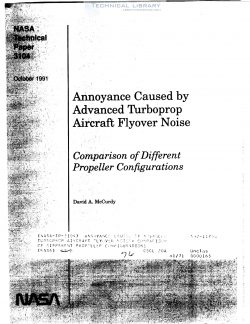NASA-TP-3104
- Version
- 73 Downloads
- 3.87 MB File Size
- 1 File Count
- May 24, 2017 Create Date
- May 24, 2017 Last Updated
NASA, Technical Paper - Annoyance Caused by Advanced Turboprop Aircraft Flyover Noise - Comparison of Different Propeller Configurations

A laboratory experiment was conducted to quan—
tify the annoyance response of people to the flyover
noise of advanced turboprop aircraft having differ-
ent propeller configurations. The propeller config-
urations were single-rotating, counter-rotating with
an equal number of blades, and counter-rotating with
an unequal number of blades. The specific objectives
were to (I) compare annoyance responses to the dis—
tinctive noises produced by the three propeller config—
urations of advanced turboprop aircraft, (2) compare
annoyance responses to the advanced turboprop air—
craft with annoyance responses to conventional tur—
boprop and turbofan aircraft, (3) determine the ef-
fects on annoyance of fundamental frequency (blade
passage frequency) and tone-to—broadband noise ra—
tio, and (4) determine the ability of aircraft noise
measurement procedures and corrections to predict
annoyance. Analyses of the data obtained from the
experiment are presented in this report.
A computer synthesis system was used to gener—
ate 40 realistic, time-varying simulations of advanced
turboprop takeoff noise. Of the 40 noises, 8 rep-
resented single—rotating propeller configurations, 12
represented counter—rotating propeller configurations
with an equal number of blades on each rotor, and 20
represented counter—rotating propeller configurations
with an unequal number of blades on each rotor. In
the experiment, 64 subjects judged the annoyance of
the synthesized advanced turboprop takeoffs along
with recordings of 5 conventional turboprop takeoffs
and 5 conventional turbofan takeoffs. Each of the
noises was presented at three sound pressure levels
to the subjects in an anechoic listening room.
Analyses of the judgments found that advanced
turboprops with single-rotating propellers were, on
average, slightly less annoying than the other air-
craft. Fundamental frequency and tone-to—broadband
noise ratio affected annoyance response to advanced
turboprops, but the effects varied with propeller con—
figuration and noise metric. The addition of du-
ration corrections and corrections for tones above
500 Hz to the noise measurement procedures im-
proved annoyance prediction ability. Duration-
corrected A-weighted sound pressure level, either
with or without tone corrections, provided the most
accurate annoyance prediction.
| File | Action |
|---|---|
| NASA-TP-3104 Annoyance Caused by Advanced Turboprop Aircraft Flyover Noise - Comparison of Different Propeller Configurations.pdf | Download |

Comment On This Post